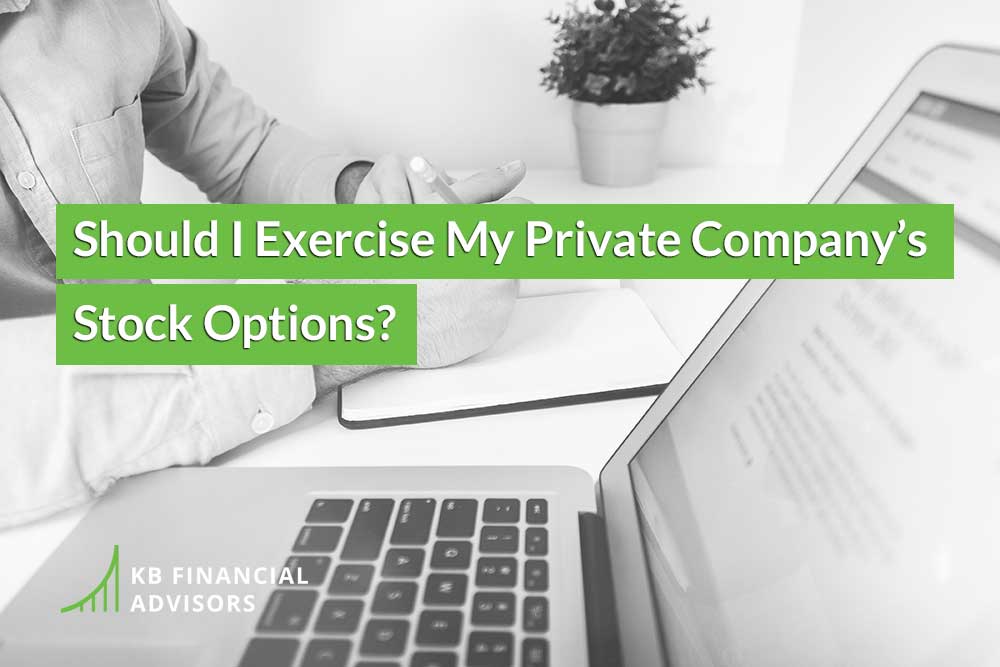So your company just announced a tender offer or IPO. The rubber is about to meet the road, and you’ve got some decisions to make about what you’re going to do with your incentive stock options (ISO).You finally have the chance to cash in on your stock options, and if you’ve got the extra cash to exercise and do some intelligent tax planning, you can really use this opportunity to exercise and hold. But with SOOO many ways to exercise, hold, wait, cash in, etc, deciding what to do can be mentally exhausting. Not only do you need to know what’s in your best financial interest, but you’ve also got to take the minefield of the tax situation around stock options into consideration. (And if you’ve been in tech for any time, I’m sure you’ve heard a few about atrocious tax bills from selling shares.) We can talk theory about finances all day long, but what really matters is how it plays out in your real life. Do you exercise and hold onto your shares for a while?Or do you hold off for now then exercise and sell later?
I’ve got a case study of a client named Stephanie to walk you through, that should help you see the situation from multiple sides to decide what’s best for you. (Disclaimer: Stephanie’s name has been changed, as well as some of her numbers for privacy’s sake. However, this IS the exact process we lead clients in this situation through every day… so nothing’s been changed there.)
Meet Stephanie, Tech Employee Since 2017
One of our clients, Stephanie, got a job at Tech Company A in 2017, and was still with them when they went through their IPO in 2021.
Throughout her time there, she’d been given TWO separate ISO grants.
She got the first one in 2017, for 15,000 ISO at an exercise price of $2.00. The current stock price is $50, this gives her a $720,000 bargain element. $50-$2 = $48. $48 x 15,0000 = $720,000.
These would cost her $30,000 to exercise and hold.
The second grant came in 2019, for 40,000 ISO at the exercise price of $3. To date, half of those 40,000 are vested, giving her 20,000 ISO at this price point.
For those 20,000 ISO, she’s got a $940,000 bargain element. $50-$3 = $47. $47 x 20,000 = $940,000.
To exercise and hold her vested shares from her 2019 grant, it would cost her $120,000.
The Basic Math: Should Stephanie Choose to Wait then Exercise and Sell, or to Exercise and Hold Now?
Today, the stock of Tech Company A is trading at $50 per share. We can’t fully predict the future, but Stephanie believes in her company, so we’ll assume the price will increase by 20% each year.
Now: $50
Year One: $60
Year Two: $72
As far as taxes, Stephanie is single, takes the standard deduction, and earns a $300,000 salary. This makes her federal income tax rate 35%, and her long-term capital gains rate 18.8% (15% plus 3.8% investment income tax).
To date, she hasn’t exercised any of her ISO.
The Math Behind Exercise and Hold
If Stephanie decides to exercise and hold all of her vested ISO, she’d have a $1,660,000 deferral item for the AMT (alternative minimum tax), which would trigger an AMT bill of $469,387. That’s higher than her yearly salary. (And why it’s a good idea to wait and exercise options like this in January… more on that below.)
If she took this option, she’d have to pay $150,000 now to exercise her options, and then she’d owe the $469,387 for AMT. That’s $619,387 total. Not the best idea in the last few months of the year… especially when that amount is more than 2x her salary.
Using Exercise and Hold as a Multi-Year Strategy
In order for Stephanie to be able to exercise all her vested options and be able to afford it, we’d have to break it down into a multi-year investment strategy.
Now: Exercise
In year one, we’d have Stephanie go ahead and exercise all of her shares, at the $150,000 price tag in January.
Year One: Sell & Pay AMT
After the first year, Stephanie’s AMT bill would come due, so she’d have to sell her shares to be able to pay it.
If she sells at the $60 per share we projected, especially after meeting the one-year threshold for long-term capital gains, her gross proceeds are $2,100,000. ($60 x 35,000 shares = $2,100,000.)
This would give her enough money to pay the $469,397 AMT, and she’d carry forward a $469,397 minimum tax credit (MTC) to use in the years to come.
Year Two: Pay Long-Term Capital Gains Tax
When you sell 35,000 shares at $60 each with a regular cost basis of $150,000, that equals a long-term capital gain of $1,950,000.
However, because of the AMT Stephanie paid, she gets to adjust her gains, so her AMT gain is only $290,000. Through the AMT she paid in year one, she was taxed up to $50 per share. The MTC keeps her from having to pay that tax again, so now the only tax she owes is the difference between the $50 price when she exercised and the $60 price when she sold.
This would add an additional tax of $113,595 in year two, because she’d get to use $342,813 in MTC and carry forward $121,987.
When it’s all said and done, Stephanie would STILL have a net cash outcome of $1,489,005.
Here’s a visual to help you out:
| Now (January) | Exercise and Trigger AMT | ($150,000) |
| Year One | Sell | $2,100,000 |
| Pay Tax on the Exercise | ($469,387) | |
| Year Two | Pay Tax on the Sell | ($113,595) |
| MTC Carry Forward | $121,987 | |
| Outcome | Net Cash | $1,489,005 |
Timing is EVERYTHING During Exercise and Hold
If you’re going to exercise and hold your shares, it’s REALLY important to get the timing right.
Exercising in the first quarter (January through March) of the year gives you the opportunity to actually hold your shares for 12 months to qualify for long-term capital gains tax BEFORE you have to sell in order to pay any tax.
Ideally, this is the order your exercise and hold strategy occurs in:
Exercise > Sell after 12+ months for long-term capital gains > Pay tax on exercise > Pay tax on sale
This way, the only cash you have to come up with to start is the cash to exercise, making this whole thing more affordable. Plus, the cash you gain from selling the shares covers the cost of your taxes, so you don’t have a financial panic attack at tax time.
The reason we’d have Stephanie exercise in January is because it gives us this multi-year setup, so she has to pay one thing each year:
- Now, she pays to exercise
- In year one, she can sell and pay the AMT bill
- Because she didn’t sell until after January in year one, she’d have another calendar year until she pays tax on the sale.
The Math Behind Exercise and Sell
Doing a same day sale is a simpler, lower-risk approach than the one above, but it can cost more in taxes.
If Stephanie chose to take this approach, she wouldn’t have to do anything right now. We’d just have her choose a price she’d be happy to sell at, and wait until her company’s shares hit that price.
For the sake of example, we’ll say she chooses $60 for a price she’d be happy to sell at, which happens in the “year one” time frame we outlined above.
When the price hits $60, she’d exercise and sell at the $60 share price, giving her gross proceeds of $1,950,000 after the $150,000 exercise cost.
In year two, she’d pay tax on the exercise and sell, and since the sale doesn’t qualify for long-term capital gains, all the income will be taxed as ordinary income.
After year two, that’d give her a $1,233,116 net cash gain. Here’s a chart to show you:
| Now | Do Nothing | $0 |
| Year One | Exercise and Same Day Sale | $1,950,000 |
| Year Two | Pay Taxes on the Sale | ($716,884) |
| Outcome | Net Cash | $1,233,116 |
Exercise and Hold vs. Exercise and Sell
In Stephanie’s case, doing the exercise and hold strategy saves her $255,889 in taxes, which increases her net cash from the deal by 21%.
On the surface, it seems like a no-brainer to take the exercise and hold approach… but it’s built on the MAJOR assumption that the price of the shares in year one is higher than the price you can sell at now… which is not always the case.
It reminds me of a story about a king tasking his wise men to record all the wisdom in the world. When they came back with a multi-volume record, the king told them, “It’s too long.” When they came back with the knowledge condensed down to one book, the king told them, “It’s too long.” But when they came back with just one sentence, the king was happy. That sentence? “There is no free lunch.”
The fact that “there is no free lunch” and why the seemingly “obvious” choice isn’t always the best is why it’s so important to work with a professional financial and tax planner. We can see the loopholes you can’t, do the math you don’t think about, and help you come up with the best plan for multiple outcomes… exercise and sell versus exercise and hold.
You can book a call with one of our financial and tax planners here, or use the button below.



